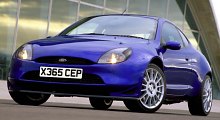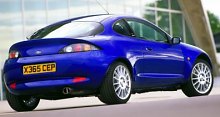Puma
Racing
 Well,
I know the car shown in the picture is a Puma ST160, but it looks
exactly
the same as the production car called Puma Racing. Why not it retains
the
ST160 name as the show car? because it didn't meet the target of 160
horsepower.
Why is it called "Racing" ? because it is built and tuned like a racing
car. One of the evidence is the failure of complying the EU emission
regulations.
As a result, it is made according to UK�s Single
Approval Vehicle regulations,
with no more than 1,000 cars built and strictly bounded to UK. Despite
of a price tag of 23,000 pounds, all cars were already sold. Well,
I know the car shown in the picture is a Puma ST160, but it looks
exactly
the same as the production car called Puma Racing. Why not it retains
the
ST160 name as the show car? because it didn't meet the target of 160
horsepower.
Why is it called "Racing" ? because it is built and tuned like a racing
car. One of the evidence is the failure of complying the EU emission
regulations.
As a result, it is made according to UK�s Single
Approval Vehicle regulations,
with no more than 1,000 cars built and strictly bounded to UK. Despite
of a price tag of 23,000 pounds, all cars were already sold.
The conversion
was made by
Tickford, the British engineering consultant which created the hottest
Ford RS200 and Cosworth RS500. Everything is familiar by racing car
standards.
Firstly, beef up the 1.7-litre Zetec engine by hotter cams, larger
intake
manifolds and low back pressure exhaust. This push the peak power to
153
hp at a high 7,000 rpm, that is, an increment of 30 hp. Secondly, to
improve
handling, front and rear tracks are widened by a massive 70 mm and 90
mm
respectively. To cover the wheels, wider aluminium front wings are used
while rear quarter panel are extended. Thirdly, also inevitably,
Tickford
stiffened the suspension springs and dampers, by the way lowered the
ride
height, enlarged the rubbers to 17-inch 215/40VR17 and upgraded the
front
brakes with 4-piston aluminium calipers. Then added a fake carbon fiber
lip spoiler to improve downforce. Lastly, the cabin is re-trimmed with
blue Alcantara steering wheel, supportive sport seats and door inserts.
After the
conversion, the
car becomes really exciting. The standard Puma is one of the best
handling
little coupe, but Puma Racing raised the game to another level - only
Honda
Integra Type R can provide such focused driving experience. The engine
roar is as thrilling as the revvy, if peaky, character. It works
perfectly
with the short-throw, close-ratio 5-speed manual (with revised linkage
to shifter) to deliver great driving pleasure, if not Type R-beating
performance.
0-60 mph is improved by 1.2 second to 7.4 sec. 0-100 mph is shortened
by
3 and a half seconds to 22.1 sec. Admittedly, this is 5 seconds away
from
a Type R, blame to the gearbox ratio which bias towards low speed and
the
lack of top end power compare with Type R. However, fooling by the
exhaust
noise, the driver might believe it were as fast as a Type R !
Every controls
feels as focused
as racing cars. The ride is stiff by any standards bar racing, so the
car
corners with virtually no roll. Massive tyres always grip the road
hard.
Understeer is inevitable for a front-drive coupe having 55% weight bias
the front, but the amount is the slightest can imagine. Lift-off
oversteer
is easily manageable. Steering is well-weighted, direct and as accurate
as a swiss watch, thanks to the stiff suspension. As a result,
cornering
is just a point-and-shoot action. Braking is powerful, with superb
brake
feel.
 Now
comes the drivablity. It must be made clear that Puma Racing is not
really
harsh and unrefined. Stiff ride it may be, but not unacceptable.
Likewise,
power delivery is peaky, but in fact it deliver no fewer punch at low
rpm
than the standard Puma. There are some vibration can be felt via
steering
wheel when riding on bumps, but not a fundamental fault for a sports
car.
Driving position is excellent, so is the seats. As in standard Puma,
the
biggest flaw is the lack of rear passenger room - it's a pure dog seat
... and I mean a puppy. Now
comes the drivablity. It must be made clear that Puma Racing is not
really
harsh and unrefined. Stiff ride it may be, but not unacceptable.
Likewise,
power delivery is peaky, but in fact it deliver no fewer punch at low
rpm
than the standard Puma. There are some vibration can be felt via
steering
wheel when riding on bumps, but not a fundamental fault for a sports
car.
Driving position is excellent, so is the seats. As in standard Puma,
the
biggest flaw is the lack of rear passenger room - it's a pure dog seat
... and I mean a puppy.
In many ways, it
is more
enjoyable to drive than a Type R Integra - engine noise (although not
in
VTEC-style), steering feel and directness, body control as well as
grip.
However, handicapped by a 121 mph top speed and a 22.1 sec 0-100 mph,
the
Puma Racing is not up to the basic requirement for performance. Then,
we
have to consider the daily usability. Why didn't the Type R or other
hot
coupes tuned so racy ? Drive the Puma Racing a whole day, then day
after
day as your daily transport and you'll know why.
If anything
justify the price
that is higher than the Type R, it must be one word: Exclusivity.
|

 After
we have seen the great styling of Ka and the great chassis of Fiesta,
we
are optimistic with Ford's forthcoming tiny coupe, Puma, which is
rumoured
to share Fiesta platform and Ka style. After we have read some test
reports
of Puma, our prediction was found to be completely correct : Puma
becomes
the best small coupe in the market.
After
we have seen the great styling of Ka and the great chassis of Fiesta,
we
are optimistic with Ford's forthcoming tiny coupe, Puma, which is
rumoured
to share Fiesta platform and Ka style. After we have read some test
reports
of Puma, our prediction was found to be completely correct : Puma
becomes
the best small coupe in the market.
 Well,
I know the car shown in the picture is a Puma ST160, but it looks
exactly
the same as the production car called Puma Racing. Why not it retains
the
ST160 name as the show car? because it didn't meet the target of 160
horsepower.
Why is it called "Racing" ? because it is built and tuned like a racing
car. One of the evidence is the failure of complying the EU emission
regulations.
As a result, it is made according to UK�s Single
Approval Vehicle regulations,
with no more than 1,000 cars built and strictly bounded to UK. Despite
of a price tag of 23,000 pounds, all cars were already sold.
Well,
I know the car shown in the picture is a Puma ST160, but it looks
exactly
the same as the production car called Puma Racing. Why not it retains
the
ST160 name as the show car? because it didn't meet the target of 160
horsepower.
Why is it called "Racing" ? because it is built and tuned like a racing
car. One of the evidence is the failure of complying the EU emission
regulations.
As a result, it is made according to UK�s Single
Approval Vehicle regulations,
with no more than 1,000 cars built and strictly bounded to UK. Despite
of a price tag of 23,000 pounds, all cars were already sold.
 Now
comes the drivablity. It must be made clear that Puma Racing is not
really
harsh and unrefined. Stiff ride it may be, but not unacceptable.
Likewise,
power delivery is peaky, but in fact it deliver no fewer punch at low
rpm
than the standard Puma. There are some vibration can be felt via
steering
wheel when riding on bumps, but not a fundamental fault for a sports
car.
Driving position is excellent, so is the seats. As in standard Puma,
the
biggest flaw is the lack of rear passenger room - it's a pure dog seat
... and I mean a puppy.
Now
comes the drivablity. It must be made clear that Puma Racing is not
really
harsh and unrefined. Stiff ride it may be, but not unacceptable.
Likewise,
power delivery is peaky, but in fact it deliver no fewer punch at low
rpm
than the standard Puma. There are some vibration can be felt via
steering
wheel when riding on bumps, but not a fundamental fault for a sports
car.
Driving position is excellent, so is the seats. As in standard Puma,
the
biggest flaw is the lack of rear passenger room - it's a pure dog seat
... and I mean a puppy.